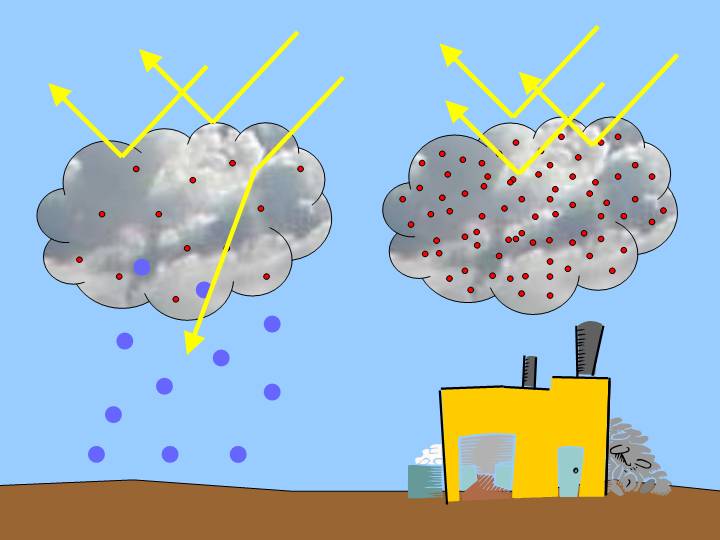|
|
 |
|
|
|
 |
| |
|
|
 |
Clouds and particles
More |
Particles and Climate
In the Basics section on "Clouds and Climate" we saw that clouds affect our climate. Firstly, they reflect around 30% of the solar energy reaching our planet back into space. Secondly, clouds trap infra-red radiation from the Earth's surface and, as a result, help heat our planet.
|
|
|
|
|
 |
|
But what role do particles have in the climate system? Do they modify the amount of energy reaching the ground in the absence of clouds? As they allow clouds to form, do they have an impact on cloud behaviour?
The direct effect of particles on climate
As well as affecting visibility, scattering and absorption of light by particles also influences our climate by reducing the amount of solar energy that reaches the surface of the Earth.
|
In 1783, a large volcanic eruption occurred in Iceland. The famous scientist Benjamin Franklin observed "a dry fog" over France, and hypothesized that the severe winter in Europe that year was linked to this "dry fog". A magnifying glass wouldn't even burn paper, he said. Franklin suggested that there was a reduction in the amount of solar energy at the Earth’s surface after the volcanic eruption.
Similarly, extinction of the dinosaurs is thought to have resulted from a meteor impact 60 million years ago. It is believed that this massive collision injected such huge amounts of dust into the atmosphere that the Sun was completely obscured for several months and that this caused severe cooling of the Earth.
|
 |
 |
 |
|
1. American scientist Benjamin Franklin (1706 - 1790). Source: www.nps.org
|
|
|
Simulations and observations after Mount Pinatubo erupted in 1991 have shown a global cooling of 0.5°C.
The direct effect of particles on climate, through scattering of solar radiation, is likely to lead to global cooling.
|
 |
 |
|
2. Haze over China. The haze is the result of forest fires, the burning of agricultural wastes, dramatic increases in the burning of fossil fuels in vehicles, industries and power stations and emissions from millions of inefficient cookers burning wood, cow dung and other 'bio fuels'. Source: UNEP, NASA.
|
|
 |
Human influence on the direct effect of aerosols
Because of industrial activity, burning of fossil fuels and forest fires humans emit large quantities of particles into the atmosphere. For example, a three kilometer deep pollution blanket known as the "Asian Brown Haze" stretches across South Asia, modifying weather patterns and endangering the health of hundreds of thousands of people. This mass of aerosols reduces the amount of solar energy reaching the Earth's surface by as much as 10 to 15%.
But aerosols have also an indirect effect on climate. Our planet hasn't heard the last of humans... |
Indirect effect of particles on climate
Indirect climate forcing by aerosols is defined as "the overall process by which aerosols perturb the Earth-atmosphere radiation balance by changing the cloud albedo and cloud amount". The indirect effects of aerosols on climate are much more difficult to assess than the direct effects. They depend on the relationship between the aerosol properties and the characteristics of the cloud. A change in the number and size of particles leads to a change in the number of cloud condensation nuclei. This change causes changes in the population and size of cloud droplets and this is likely to change the albedo of the cloud (how much solar radiation the cloud reflects back into space).
The influence of humans on the indirect effect of particles
Anthropogenic processes produce large amounts of small particles. These anthropogenic aerosols are believed to have two major effects on cloud properties. Firstly, the increased number of CCN results in a larger number of smaller cloud droplets leading to enhanced scattering of light within clouds and an increase in cloud albedo. Secondly, as droplets are smaller, there is less rain, cloud lifetimes are longer and the average cloud cover over the Earth is greater.
Both effects reduce the amount of sunlight absorbed by Earth and thus tend to cause global cooling.
|
Figure 3. shows the indirect effect of particles: polluted clouds send more solar radiation back to space, and rainfall is inhibited because the cloud droplets are small.
|
 |
 |
 |
|
3. Human influence on the indirect effect of aerosols.
Author: Justine Gourdeau.
|
|
|
The relationships between particles and the albedo of a cloud are very complex so we are still unsure how important this indirect aerosol effect is to our climate. We are, however, sure that particles do play a very important role in the overall radiation budget of the Earth.
About this page....
author: Justine Gourdeau - LaMP, Clermont-Ferrand, France
scientific reviewer: Dr. Vincent Giraud - LaMP, Clermont-Ferrand, France
last published: 2004-04-26
|
|
 |
|







